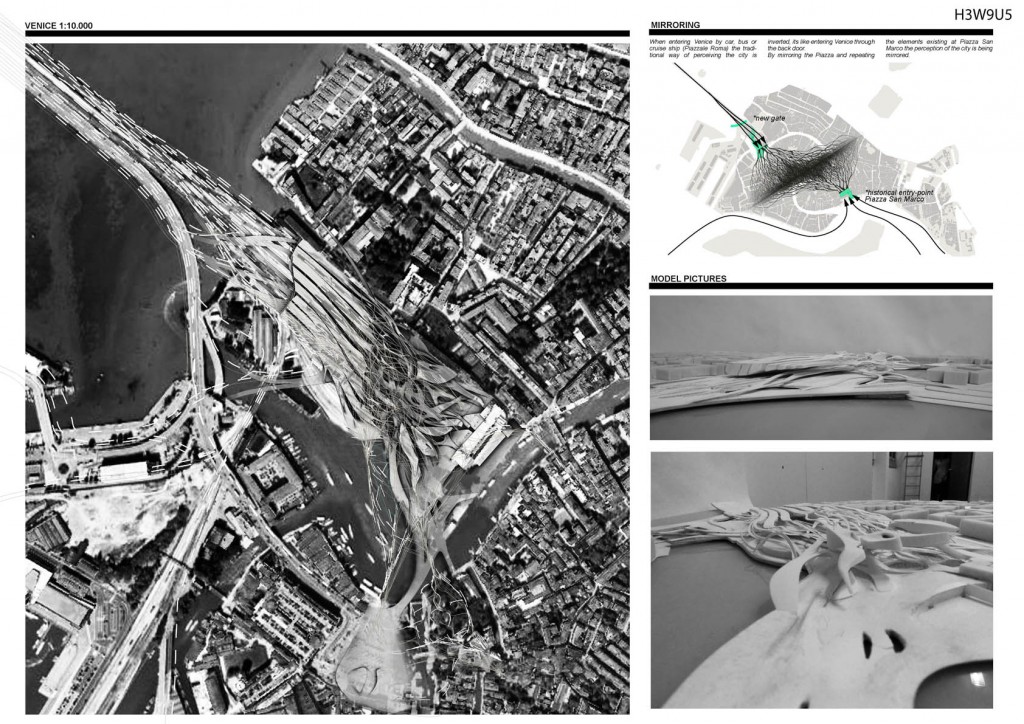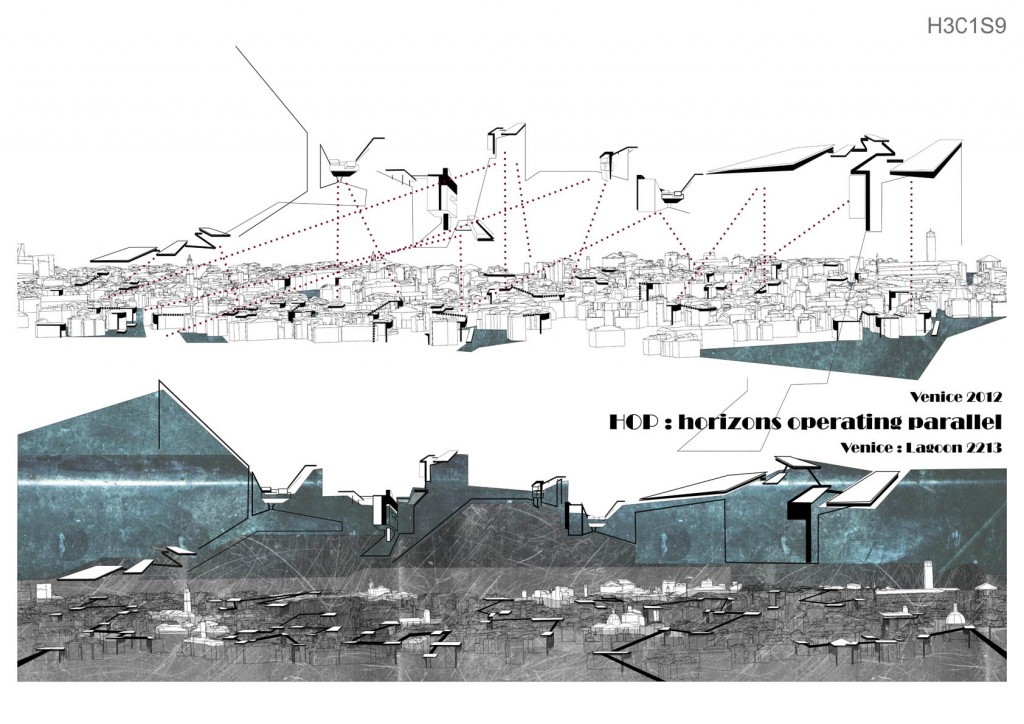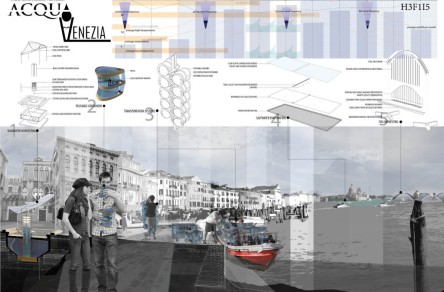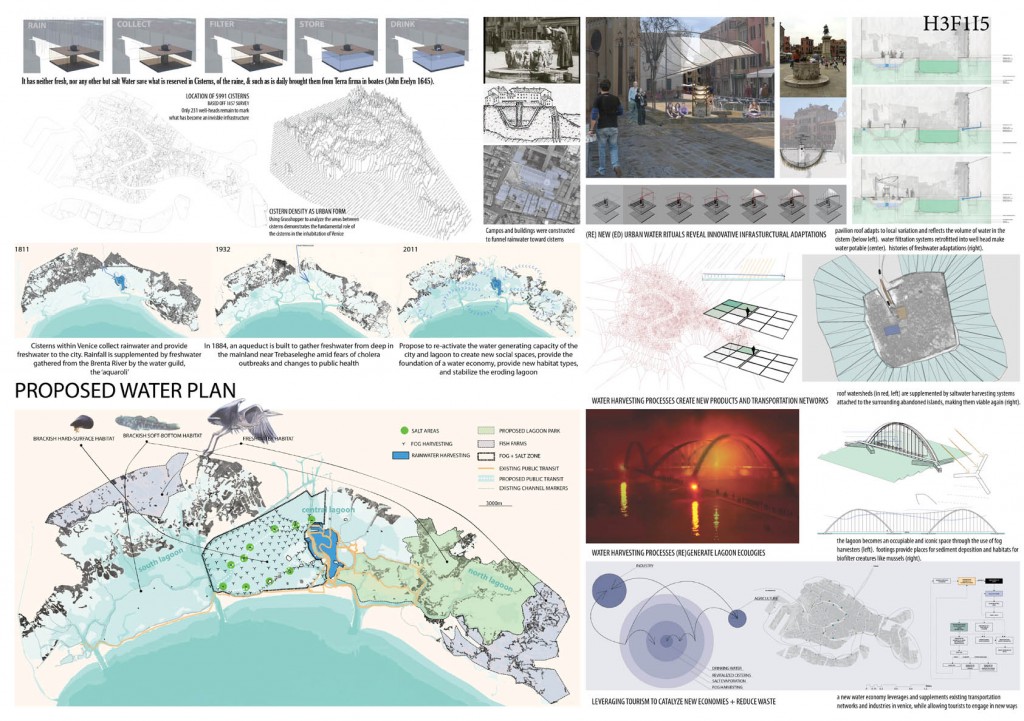Info:
Title: Acqua Venezia - Code: H3F1I5Contest: Venice / 2011
By: N. Keroack / A. Bush / J. Sieweke
Views: 3849 Likes: 0
Votes:
BJARKE INGELS7 NERI OXMAN7 ELENA MANFERDINI3 MARIA LUDOVICA TRAMONTIN6 BOSTJAN VUGA45.4
Acqua Venezia
BACKGROUND Venice is a city that has existed as the product of the rituals of daily life. Human power and manual labor have been and continue to be the important source of energy for the city, and most of the movement of goods and services continue to happen at the body scale (carts, small boats, buckets). The once great Venice of the 14th and 15th centuries has gone into deep decline (and may never be so dominant again), and modern efforts to revive the city have failed. The petrochemical plant at Porto Marghera briefly augmented the economy of Venice and Mestre, yet brought great environmental damage to the lagoon and contributed to the subsidence of the city. Tourism provides the economic base of the current economy, but it arguably destroys as much as it supports.
While tourism provides a source of economic benefit for the city, it also has many costs. In particular, trash removal is a serious problem for Venice, in large part because of the scale of the city, where trash is collected by hand. Venetian authorities have mounted campaigns to get residents to drink more tap water and lessen the use of plastic water bottles, which has had success in reducing the amount of garbage generated by the city; however, these campaigns have failed to effectively target tourists.
Since the 1960’s Venice has lost a significant amount of its population, due in part to the combined forces of increased tide and increased tourism as other industries have declined. The very people necessary to maintain Venice continue to depart.
Thus, we argue that Venice is not sustainable as it currently exists; the pressures of increased tourism that demand a consistent image of Venice, prevent it from adapting to new challenges. We hope to imagine an alternative economic force for Venice that takes advantage of its current industries (tourism, fishing, glassmaking, lace) and setting within the lagoon to provide a more diverse set of industries, practices and rituals within Venice to enable it to thrive as a flexible managed system, upsized to better manage the increasing demands of tourism.
Historically, water in Venice was a more public amenity, supplied by a distributed network of 6000 rainwater harvesting cisterns. This network has been completely abandoned, but the infrastructure still exists in the grading of every campo and sand filter beneath its stones. Currently, Venice draws water from distant sources and pipes it though aqueducts to supply the city. Drawing water from distant sources can create many conflicts of interest and creates inequities and disconnects between upstream and downstream communities. We believe there is water generating capacity in the lagoon that could be explored as an alternative source. As future bans on aquifer withdrawal go into effect (for example, agricultural use on San Erasmo) we would like to propose new more resilient strategies for water procurement.
We propose to revive this system of public water as a source for tourists, as an economic catalyst for a broader water economy, a more sustainable form of tourism, a reimagination of public space and water in the city and the lagoon, and a chance to revive the processes and ecological relationships between the city of Venice and its lagoon.
PROPOSAL
1. Make potable water available at refurbished wellheads.
2. Design a water container that is both attractive for a souvenir and for reuse, and encourage both Venetians and tourists to use it, developing a “brand” of water in Venice. These bottles could be locally produced using the skilled glass workers of Murano, and generate new jobs through the deployment of this service.
3. Expand and scale the water system through local use of fog condensers and desalination centers. These systems would be concentrated in the central region of the lagoon and add a new structure to an area that is becoming an open bay through the erosion caused by dredging deep navigation channels.
4. Establish a method for water shipping, transport, and water bottle washing that meshes with the vaporetto and current lagoon scale transportation systems.
5. Open the possibility of a water knowledge network that encourages research and collaboration with other coastal regions with similar climate and water needs
This will take place across scales and will focus on an overhaul of the entire system with the goal of establishing both new and old infrastructures and inscribing new urban routines. Our sites and scales are as follows:
1. Scale of the Body: a functional and easily transported water container that can be bought as a souvenir or returned for reuse
2. Scale of the City: Redevelopment of the existing cistern infrastructure; networks of water and container distribution centers
3. Scale of the Lagoon: Water collection through fog harvesting and desalination to reinvigorate and create new transportation options, public spaces, and ecological potential by creating habitat and countering erosion; formation of a lagoon scale water economy for drinking as well as agricultural and industrial use
4. Scale of the Globe: Open the possibility for future knowledge transfers to other coastal regions looking for more resilient water procurement
OUTCOMES
• Reconnect both Venetian citizens and tourists to the productive nature of the Lagoon ecosystem.
• Showcase Venice as a series of cooperative systems and flows, historically and currently
• Reduce waste and encourage a new kind of tourism that appreciated process as well as object
• [Re]create new centers of urban interaction around public drinking fountains.
• Respond to larger ecological cycles of Venice (rain, fog, climate, salinity and lagoon dynamics)
• Build a model of hybrid infrastructure that harnesses ecological flows with low-energy technology that could benefit multiple ecologies of the lagoon (ecological, industrial, economic, social/public space)
Related Posts :
Comments:
Info:
Title: Acqua Venezia
Time: 7 giugno 2011
Category: Venice
Views: 3849 Likes: 0
Tags: A. Bush , Adriatic Sea , Environment , J. Sieweke , Lagoon , Mestre , Murano , N. Keroack , Tourism , Venetians , Venice








